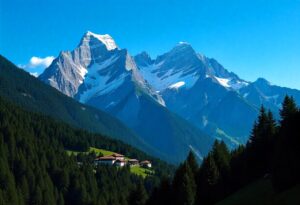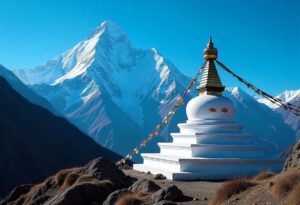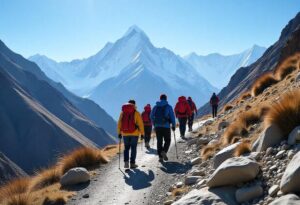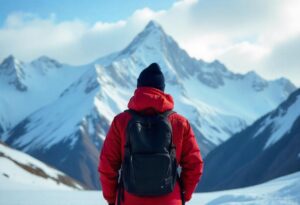Everest Base Camp Trek in Nepal is an adventure of a lifetime. It attracts trekkers from all over the world.
Imagine standing face to face with the world’s highest peak. Everest Base Camp Trek offers this incredible experience. Nestled in the heart of the Himalayas, this trek presents a challenging yet rewarding journey. It takes you through vibrant Sherpa villages, ancient monasteries, and stunning landscapes.
Each step brings you closer to the majestic Mount Everest. The trek is not just about the destination but also the journey. The culture, nature, and camaraderie among trekkers make it unique. Ready for an unforgettable adventure? Everest Base Camp awaits you!
Introduction To Everest Base Camp Trek
The Everest Base Camp Trek in Nepal is a dream journey for many adventure lovers. This trek offers breathtaking views of the Himalayas, including the iconic Mount Everest. It takes you through charming Sherpa villages, ancient monasteries, and diverse landscapes. The trek is not just about reaching the base camp but also about experiencing the rich culture and hospitality of the local people. The following sections provide an introduction to the Everest Base Camp Trek and what you can expect during this incredible adventure.
What To Expect
The Everest Base Camp Trek is a challenging yet rewarding experience. It spans approximately 130 kilometers (round trip) and takes about 12-14 days to complete. Trekkers can expect to walk around 5-7 hours daily, covering distances of 10-15 kilometers per day. The trek begins from the vibrant town of Lukla and passes through several key locations:
- Phakding: A small village that serves as the first stop for acclimatization.
- Namche Bazaar: Known as the gateway to Everest, this bustling town offers stunning views and is perfect for acclimatization.
- Tengboche: Home to the famous Tengboche Monastery, offering spiritual relief and breathtaking scenery.
- Dingboche: Another acclimatization spot with amazing panoramic views.
- Lobuche: The final village before the base camp, where trekkers prepare for the last stretch.
Expect varying weather conditions, with temperatures ranging from mild to extreme cold. The higher you go, the thinner the air, making acclimatization crucial. Trekkers might also experience symptoms of altitude sickness, so it’s essential to stay hydrated and take necessary precautions.

Best Time To Visit
The best time to visit Everest Base Camp is during the pre-monsoon (spring) and post-monsoon (autumn) seasons. These periods offer the most stable weather conditions and the clearest mountain views. Here is a breakdown:
| Season |
Months |
Conditions |
| Spring |
March to May |
Warm temperatures, blooming rhododendrons, clear skies |
| Autumn |
September to November |
Crisp air, clear views, fewer clouds |
Spring, from March to May, is a popular time due to moderate temperatures and blossoming flowers. Trekkers can enjoy colorful landscapes and stable weather. Autumn, from September to November, offers clear skies and excellent visibility of the mountains. This season is also favored due to its cool, crisp air and dry conditions.
Winter (December to February) and summer (June to August) are less ideal. Winter brings harsh cold and snow, making some paths inaccessible. Summer coincides with the monsoon season, leading to slippery trails and lower visibility due to rain and clouds.
Preparing For The Trek
The Everest Base Camp Trek in Nepal is a dream adventure for many. To make this journey successful, proper preparation is key. Preparing for the trek involves ensuring you are physically fit and have the right gear. This guide will help you get ready for one of the most memorable experiences of your life.
Physical Fitness
Physical fitness is crucial for the Everest Base Camp Trek. The trek involves long hours of walking on rugged terrain and high altitudes. It is important to start training several months before your trek.
Here are some tips to help you get in shape:
- Cardiovascular Exercises: Include running, cycling, and swimming in your routine. Aim for at least 30 minutes of cardio exercises, five days a week.
- Strength Training: Focus on leg muscles. Squats, lunges, and step-ups are great exercises. Train with weights to build endurance.
- Hiking Practice: Go on hikes with a backpack. This simulates the actual trekking experience. Start with short hikes and gradually increase the distance and altitude.
- Flexibility Exercises: Incorporate yoga and stretching exercises. These help prevent injuries and improve balance.
Track your progress and adjust your training intensity as needed. Listen to your body and rest when necessary. Consistency is key to building the stamina needed for the trek.

Gear Checklist
Having the right gear is essential for a comfortable and safe trek. Here is a detailed checklist to ensure you are well-prepared:
| Item |
Details |
| Backpack |
40-50 liters capacity, with rain cover |
| Clothing |
Layered clothing system, including thermal wear, fleece jacket, down jacket, waterproof jacket, trekking pants, and thermal socks |
| Footwear |
Sturdy trekking boots, broken in before the trek, and comfortable trekking shoes for lower altitudes |
| Accessories |
Beanie, sun hat, gloves, sunglasses, trekking poles, and headlamp |
| Sleeping Gear |
Sleeping bag rated for -15°C, sleeping bag liner |
| Personal Items |
Sunscreen, lip balm, personal hygiene items, first aid kit, water bottles, water purification tablets, and snacks |
Ensure all your gear is of good quality and tested before the trek. Pack light but don’t miss the essentials. Being well-equipped will enhance your trekking experience and keep you safe.
Trekking Itinerary
The Everest Base Camp Trek in Nepal is a dream for many adventure lovers. This trek offers a unique chance to walk in the footsteps of legends. The journey takes you through beautiful landscapes, friendly villages, and stunning views of the Himalayas. To help you plan, here is a detailed trekking itinerary that includes a day-by-day breakdown and alternative routes.
Day-by-day Breakdown
Embarking on the Everest Base Camp Trek requires a well-structured plan. Here’s a detailed breakdown to guide you:
| Day |
Activity |
Elevation |
| Day 1 |
Fly to Lukla and trek to Phakding |
2,610m |
| Day 2 |
Trek from Phakding to Namche Bazaar |
3,440m |
| Day 3 |
Acclimatization day at Namche Bazaar |
3,440m |
| Day 4 |
Trek from Namche Bazaar to Tengboche |
3,860m |
| Day 5 |
Trek from Tengboche to Dingboche |
4,410m |
| Day 6 |
Acclimatization day at Dingboche |
4,410m |
| Day 7 |
Trek from Dingboche to Lobuche |
4,940m |
| Day 8 |
Trek from Lobuche to Gorak Shep and Everest Base Camp, then return to Gorak Shep |
5,364m |
| Day 9 |
Hike to Kala Patthar, then trek to Pheriche |
5,545m |
| Day 10 |
Trek from Pheriche to Namche Bazaar |
3,440m |
| Day 11 |
Trek from Namche Bazaar to Lukla |
2,860m |
| Day 12 |
Fly back to Kathmandu |
1,400m |
This itinerary ensures proper acclimatization and provides a balanced mix of trekking and rest days. Namche Bazaar and Dingboche are key points for acclimatization. The hike to Kala Patthar offers an unforgettable view of Everest. Each day’s trek varies in difficulty, so be prepared for both easy and challenging sections.

Alternative Routes
The standard route to Everest Base Camp is popular, but there are alternative paths for those seeking a different experience:
- Gokyo Lakes Trek: This route takes you through the beautiful Gokyo Valley. It includes a visit to the stunning Gokyo Lakes and the Gokyo Ri viewpoint. This path rejoins the main EBC trail at Lobuche.
- Three Passes Trek: This challenging route includes crossing three high passes: Kongma La, Cho La, and Renjo La. It offers stunning views and fewer crowds. Ideal for seasoned trekkers looking for a tough adventure.
- Jiri to Everest Base Camp Trek: This classic route starts from Jiri, adding extra trekking days. It gives a deeper cultural experience and a gradual ascent, aiding acclimatization.
Each alternative route has its own charm. The Gokyo Lakes Trek offers serene lakes and fewer trekkers. The Three Passes Trek is for those wanting to push their limits. The Jiri route provides a historical trekking experience. Choose based on your fitness level, time, and what kind of adventure you seek.
Cultural Experiences
Embarking on the Everest Base Camp Trek in Nepal is not just about breathtaking landscapes and physical challenges. The cultural experiences along the way enrich the journey, offering a unique glimpse into the lives of the local communities. From the warm hospitality of the Sherpas to the vibrant festivals that color their traditions, the cultural encounters add a profound layer to your adventure.
Local Communities
The trail to Everest Base Camp winds through several Sherpa villages, each with its own unique charm and welcoming residents. The Sherpa people are renowned for their mountaineering skills, but their rich cultural heritage is equally compelling.
As you pass through villages like Namche Bazaar, Tengboche, and Dingboche, you will experience the daily lives of the Sherpas. They are known for their friendliness and hospitality. You might be invited into homes for a cup of butter tea or to share a meal. This is a great opportunity to learn about their way of life.
- Namche Bazaar: The bustling hub of the Khumbu region, with markets and traditional shops.
- Tengboche: Famous for its monastery, offering spiritual insights and stunning views of Everest.
- Dingboche: Known for its agricultural practices and stone-walled fields.
Additionally, you can visit local schools and hospitals, often supported by trekking groups and international donors. These visits provide a deeper understanding of the challenges and resilience of the mountain communities.
Engaging with local artisans and purchasing handmade crafts supports the community and offers unique souvenirs. The intricate designs in their weaving, jewelry, and other crafts reflect their cultural stories and traditional skills.
Festivals And Traditions
The Everest region is alive with festivals and traditions that offer a vibrant cultural tapestry. These celebrations are deeply rooted in Tibetan Buddhism and Sherpa customs, providing trekkers with a rich cultural immersion.
One of the most significant festivals is
Mani Rimdu, celebrated at Tengboche Monastery. This festival includes elaborate mask dances, prayers, and rituals. It is a time of community gathering and spiritual renewal.
Other notable festivals include:
- Dumji Festival: Celebrated in June, this festival honors the birth of Guru Rinpoche, the founder of Tibetan Buddhism. It includes traditional dances and communal feasts.
- Losar: The Tibetan New Year, marked by music, dance, and feasts. It is a time for family gatherings and cultural performances.
During these festivals, the local people dress in their finest traditional attire, adding to the visual splendor. The vibrant colors and intricate designs of their clothing are a feast for the eyes.
Participating in these festivals offers a deep sense of connection to the Sherpa culture. It allows trekkers to witness the spiritual and communal life of the people who call these mountains home. You will leave with a greater appreciation of their traditions and beliefs.
Wildlife And Nature
Embarking on the Everest Base Camp Trek in Nepal promises an unforgettable adventure through some of the most stunning natural landscapes in the world. The trek not only offers a glimpse of the majestic Mount Everest but also immerses you in a diverse array of wildlife and nature. From vibrant flora to unique fauna, the journey is a naturalist’s dream come true. Let’s explore the rich tapestry of wildlife and nature that awaits you on this incredible trek.

Flora And Fauna
The Everest Base Camp Trek is a paradise for those who love nature. The trek spans various altitudes, each hosting different types of plants and animals. At lower elevations, you will see lush forests filled with rhododendron, birch, and pine trees. As you climb higher, the vegetation changes to hardy shrubs and mosses.
The region is home to a variety of wildlife:
- Musk Deer: These shy animals are often spotted in the dense forests.
- Snow Leopard: Though rare, these elusive predators roam the higher altitudes.
- Himalayan Tahr: A type of wild goat commonly seen grazing on steep cliffs.
Birdwatchers will be thrilled with the diversity of bird species:
| Bird Species |
Description |
| Himalayan Monal |
The national bird of Nepal, known for its iridescent plumage. |
| Blood Pheasant |
A colorful bird often seen in high-altitude forests. |
| Golden Eagle |
A majestic bird of prey frequently seen soaring above the valleys. |
Each step of the trek offers new opportunities to encounter the region’s rich biodiversity. Keep your camera ready to capture these incredible moments.
Scenic Views
The scenic views on the Everest Base Camp Trek are unparalleled. As you trek through the Khumbu Valley, you will be treated to breathtaking vistas at every turn.
Some highlights include:
- Nuptse and Lhotse: These towering peaks provide a stunning backdrop to your journey.
- Khumbu Glacier: A massive river of ice that is a sight to behold.
- Gokyo Lakes: Pristine turquoise lakes that reflect the surrounding snow-capped peaks.
From the vantage points along the trail, you can enjoy panoramic views of the Himalayan range. The sunrise at Kala Patthar is particularly spectacular, offering an unobstructed view of Mount Everest bathed in golden light.
The trek also takes you through charming Sherpa villages. These villages are surrounded by terraced fields and overlooked by towering mountains. Visiting these villages gives you a glimpse into the traditional lifestyle of the Sherpa people.
The Everest Base Camp Trek is not just a physical journey. It is an experience that feeds the soul with its awe-inspiring natural beauty. Every day on the trail brings new vistas that are more breathtaking than the last.
Health And Safety Tips
The Everest Base Camp Trek in Nepal is a dream adventure for many. The trek offers stunning views and a chance to experience the culture of the Sherpa people. But, it’s crucial to stay safe and healthy. Here are some health and safety tips to help you on your journey.
Altitude Sickness
Altitude sickness is a common issue for trekkers at high elevations. It can affect anyone, regardless of fitness level. Symptoms include headache, nausea, and dizziness. To prevent it, follow these tips:
- Acclimatize gradually: Spend a few days at an intermediate altitude before heading higher.
- Stay hydrated: Drink plenty of water to help your body adjust.
- Avoid alcohol and caffeine: These can dehydrate you and worsen symptoms.
- Take it slow: Walk at a steady pace and take regular breaks.
- Medications: Consider taking Diamox (acetazolamide) after consulting with your doctor.
If symptoms persist, descend immediately. Severe altitude sickness can be life-threatening. Here’s a simple table to help you recognize the symptoms:
| Symptom |
Severity |
| Headache |
Mild to severe |
| Nausea |
Mild to severe |
| Dizziness |
Mild to severe |
| Shortness of breath |
Moderate to severe |
| Confusion |
Severe |
Emergency Procedures
Emergency situations can arise on the trek. Knowing what to do can save lives. Here are important steps:
- Have a plan: Know the location of the nearest medical facilities and emergency contacts.
- Carry a first aid kit: Include bandages, antiseptics, pain relief, and altitude sickness medication.
- Use a guide: Local guides know the terrain and can help in emergencies.
- Stay connected: Use a satellite phone or GPS device for communication in remote areas.
- Insurance: Ensure your travel insurance covers high-altitude trekking and emergency evacuation.
If someone in your group has severe symptoms, act quickly. Here’s a step-by-step emergency procedure:
- Recognize symptoms: Severe headache, confusion, or inability to walk.
- Stop and rest: Do not continue trekking.
- Administer oxygen: If available, provide supplemental oxygen.
- Descend immediately: Move to a lower altitude as fast as possible.
- Seek medical help: Contact emergency services or head to the nearest medical facility.
Staying safe and healthy ensures you enjoy the Everest Base Camp Trek. Proper preparation and awareness make all the difference.
Trekking Costs
The Everest Base Camp Trek in Nepal is a dream for many adventure enthusiasts. But, understanding the trekking costs is crucial for a smooth journey. Several factors influence the overall expense, including permits, accommodation, food, and gear. Knowing these costs helps in planning a budget-friendly trek.
Budgeting For The Trek
Planning a budget for the Everest Base Camp Trek involves considering various expenses. Here’s a breakdown of what to expect:
- Flights: The flight from Kathmandu to Lukla costs around $150 to $200 one way. This is a significant part of the budget.
- Accommodation: Tea houses along the trekking route charge $5 to $10 per night. Prices increase as you go higher.
- Meals: Meals cost between $5 to $15 per meal. Budget around $30 to $40 daily for food.
- Guides and Porters: Hiring a guide costs approximately $25 to $30 per day. Porters charge around $15 to $20 daily.
- Gear: Renting gear like sleeping bags and down jackets costs about $1 to $2 per item per day.
Here’s a table summarizing the key costs:
| Expense |
Cost (USD) |
| Flights (round trip) |
300 – 400 |
| Accommodation (per night) |
5 – 10 |
| Meals (per day) |
30 – 40 |
| Guide (per day) |
25 – 30 |
| Porter (per day) |
15 – 20 |
| Gear rental (per item per day) |
1 – 2 |
Budgeting accurately ensures you have a comfortable and enjoyable trek. Keep a buffer for unexpected expenses.
Permits And Fees
Permits and fees are essential components of the Everest Base Camp Trek. You need two main permits:
- Sagarmatha National Park Permit: This permit costs around $30. You need it to enter the national park.
- Khumbu Pasang Lhamu Rural Municipality Permit: This permit costs approximately $20. It’s required for trekking in the Khumbu region.
You can obtain these permits in Kathmandu or Monjo. Here’s a breakdown of the permit costs:
| Permit |
Cost (USD) |
| Sagarmatha National Park Permit |
30 |
| Khumbu Pasang Lhamu Rural Municipality Permit |
20 |
Additional costs may include:
- TIMS Card: Trekkers Information Management System (TIMS) card costs around $10 to $20. It’s required for safety and rescue purposes.
- Insurance: Trekking insurance is crucial. It covers medical and evacuation costs. Prices vary depending on the provider and coverage.
Ensure you have all necessary permits before starting your trek. This avoids fines and ensures a hassle-free experience.
Sustainable Trekking
The Everest Base Camp Trek in Nepal is a dream for many adventurers. To preserve this stunning environment, sustainable trekking is essential. By practicing sustainable trekking, we ensure that the beauty of the Himalayas remains intact for future generations. Let’s explore the key aspects of sustainable trekking: Leave No Trace principles and supporting local economies.
Leave No Trace Principles
Leave No Trace (LNT) principles are critical for maintaining the pristine condition of the Everest region. These principles guide trekkers to minimize their environmental impact. Here are some of the key LNT principles:
- Plan Ahead and Prepare: Research your route and be aware of local regulations. This reduces the risk of unexpected impacts.
- Travel and Camp on Durable Surfaces: Stick to established trails and campsites. This prevents soil erosion and damage to vegetation.
- Dispose of Waste Properly: Pack out all trash and use designated toilet facilities. Never leave waste behind.
- Leave What You Find: Preserve the natural environment by not picking plants or disturbing wildlife.
- Minimize Campfire Impact: Use a stove for cooking instead of fires. Campfires can leave a lasting scar on the landscape.
- Respect Wildlife: Observe animals from a distance. Do not feed them as it disrupts their natural habits.
- Be Considerate of Other Visitors: Keep noise levels down and respect the experiences of other trekkers.
By following these principles, trekkers can help protect the Everest region. The goal is to leave the area as beautiful as we found it.
Supporting Local Economies
Supporting local economies is another crucial aspect of sustainable trekking. The Everest Base Camp Trek passes through many villages. Trekkers can contribute to these communities in several ways:
- Hiring Local Guides and Porters: Employing local guides and porters provides them with income and supports their families.
- Staying in Local Lodges: Choosing to stay in locally-owned lodges helps keep money within the community.
- Buying Local Products: Purchasing handmade crafts and local goods supports artisans and small businesses.
- Eating Local Food: Enjoying meals at local teahouses boosts the local food economy and ensures fresh ingredients are used.
Below is a table summarizing how trekkers can support the local economy:
| Action |
Benefit |
| Hire Local Guides |
Creates jobs and supports families |
| Stay in Local Lodges |
Keeps money in the community |
| Buy Local Products |
Supports artisans and small businesses |
| Eat Local Food |
Boosts local food economy |
By taking these steps, trekkers help improve the well-being of the local people. This ensures that the benefits of tourism are shared with those who need it most.
Conclusion
Experiencing the Everest Base Camp trek is truly unforgettable. The breathtaking views amaze everyone. You will meet friendly locals along the way. The challenge of the trek builds character. Memories made here last a lifetime. Adventure seekers find joy in every step.
Embrace the beauty and culture of Nepal. Prepare well and enjoy this unique journey. Ready for the adventure of a lifetime? Your Everest Base Camp trek awaits!




